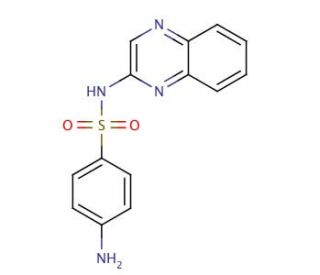

Sulfaquinoxaline (CAS 59-40-5)
QUICK LINKS
Sulfaquinoxaline, a member of the sulfonamide class, serves as a feed additive for the prevention and treatment of poultry leucocytozoonosis and coccidiosis. This sulfonamide antibiotic finds application in veterinary medicine and the meat and poultry industries. Also known as kokozigal or sulfa-Q, sulfaquinoxaline falls within the quinoxalines class of organic compounds, featuring a quinoxaline moiety—a bicyclic heterocycle composed of a fused benzene and pyrazine ring. It is a practically insoluble solid with a relatively neutral nature, primarily residing in the cytoplasm within cells. Primarily used as a veterinary medicine, sulfaquinoxaline is administered to cattle and sheep to combat coccidiosis. Acting as a bacteriostatic agent, sulfonamides impede the synthesis of folic acid in bacterial cells by competing with paraaminobenzoic acid (PABA) for incorporation into the folic acid molecule. This substitution disrupts the formation of folic acid required for DNA synthesis, inhibiting bacterial proliferation. It is important to note that susceptible organisms rely on synthesizing their own folic acid, while mammalian cells utilize preformed folic acid and remain unaffected. Resistance can occur through excess PABA production or environments rich in PABA, which compete with sulfonamides. Sulfonamides act as structural analogs and competitive antagonists of PABA, preventing bacterial utilization of PABA for synthesizing folic acid (pteroylglutamic acid). Specifically, sulfonamides competitively inhibit dihydropteroate synthase, the bacterial enzyme responsible for incorporating PABA into dihydropteroic acid, the immediate precursor of folic acid. Sensitive microorganisms are those that must synthesize their own folic acid, while bacteria capable of utilizing preformed folate are unaffected. Bacteriostasis induced by sulfonamides is counteracted by PABA in a competitive manner. Importantly, this mechanism does not impact mammalian cells, as they require preformed folic acid and lack the ability to synthesize it.
Sulfaquinoxaline (CAS 59-40-5) References
- Sulfaquinoxaline in the Control of Eimeria tenella and Eimeria necatrix in Chickens on a Commercial Broiler Farm. | Grumbles, LC., et al. 1948. Science. 107: 196. PMID: 17791764
- Sulfaquinoxaline in the prevention and control of chronic fowl cholera. | DELAPLANE, JP. and HIGGINS, TC. 1948. Cornell Vet. 38: 267-72. PMID: 18873076
- Sorption and desorption of sulfadimethoxine, sulfaquinoxaline and sulfamethazine antimicrobials in Brazilian soils. | Doretto, KM., et al. 2014. Sci Total Environ. 476-477: 406-14. PMID: 24486496
- Influence of pH and ozone dose on sulfaquinoxaline ozonation. | Urbano, VR., et al. 2017. J Environ Manage. 195: 224-231. PMID: 27558831
- Sulfaquinoxaline inhibition of vitamin K epoxide and quinone reductase. | Preusch, PC., et al. 1989. Arch Biochem Biophys. 269: 18-24. PMID: 2916837
- Comparison of the toxicity of waters containing initially sulfaquinoxaline after photocatalytic treatment by TiO2 and polyaniline/TiO2. | Sandikly, N., et al. 2021. Environ Technol. 42: 419-428. PMID: 31180807
- Sulfaquinoxaline Oxidation and Toxicity Reduction by Photo-Fenton Process. | Urbano, VR., et al. 2021. Int J Environ Res Public Health. 18: PMID: 33498745
- Sensitive electrochemical aptasensor for determination of sulfaquinoxaline based on AuPd NPs@UiO-66-NH2/CoSe2 and RecJf exonuclease-assisted signal amplification. | Li, S., et al. 2021. Anal Chim Acta. 1182: 338948. PMID: 34602189
- An AuNPs-Based Fluorescent Sensor with Truncated Aptamer for Detection of Sulfaquinoxaline in Water. | Chen, X., et al. 2022. Biosensors (Basel). 12: PMID: 35884316
- Identification of folic acid and sulfaquinoxaline using a heterometallic Zn-Eu MOF as a sensor. | Li, D., et al. 2023. Dalton Trans. 52: 696-702. PMID: 36545891
- Tissue-residue depletion of sulfaquinoxaline in poultry. | Righter, HF., et al. 1970. Am J Vet Res. 31: 1051-4. PMID: 5430695
- Liquid chromatographic analysis of sulfaquinoxaline and its application to pharmacokinetic studies in rabbits. | Eppel, JG. and Thiessen, JJ. 1984. J Pharm Sci. 73: 1635-8. PMID: 6520769
- Effectiveness of therapeutic anticoccidial drugs against recently isolated coccidia. | Mathis, GF., et al. 1984. Poult Sci. 63: 1149-53. PMID: 6739406
Ordering Information
| Product Name | Catalog # | UNIT | Price | Qty | FAVORITES | |
Sulfaquinoxaline, 100 mg | sc-220167 | 100 mg | $270.00 |
